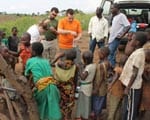Interdisciplinary approach teaches soft skills like cooperation and communication across disciplines and genders
The Innovation Gym in SMU’s Lyle School of Engineering was buzzing and clanking on a recent morning as students tested robots they built for a specific task — collecting and remediating water samples. Lyle faculty and students have been doing the water work by hand in refugee camps in Africa and Bangladesh.
The strong work dynamic that emerged among members of the first-year design class and their embrace of the inter-disciplinary team approach used to teach it has drawn the attention of the Center For Creative Leadership, which will send a team of researchers to SMU Lyle in fall 2013 to study the student techniques.






What the team gleans from observing the SMU course could foster new tools and processes that can benefit organizations and educational institutions around the country.
“I had a chance to visit the Lyle School in February and see first-hand the innovative structure of the first-year design course,” said Kristin Cullen, faculty researcher with CCL’s Research, Innovation and Product Development Group. “Using student teams – really cross-functional teams – and having them work on a very intense project really does mirror the type of environment students will be in when they leave college and enter the workplace.”
“They are using what we would call agile work processes.” Cullen said. “We’re very interested in working with the Lyle School to learn about the relationships and the networks these students develop over the course of their project to learn what makes them successful as a team and as individuals in the course. The plan moving forward is to share what we find with other universities.”
Cullen expects that her team will provide feedback to the students and teachers throughout the fall, but says they will also return at the end of the semester to show the SMU Lyle students what they have learned from observing them.
“This kind of experience is as much about teaching soft skills like cooperation and communication across disciplines and genders as it is about engineering,” said Andrew Quicksall, the Lyle School’s J. Lindsay Embrey Assistant Professor. The robotics assignment that the first-year design students have been working on this academic year is based on the remediation work Quicksall and Lyle graduate students have been doing in refugee camps where ongoing water quality issues are posing health problems.
The Lyle School’s Hart Center for Engineering Leadership began a partnership in 2011 with CCL, a global nonprofit education and research organization, to bring leadership development to all Lyle students. One of CCL’s goals in the partnership is to prepare students to work in volatile and fast-changing work environments, said Preston Yarborough, CCL project manager at the Lyle School. “Success in today’s workplace requires an astute understanding of the informal networks that really drive how organizations work,” Yarborough said.
Teaching the first-year design course is a team experience, too – tapping the skills of Quicksall, an environmental engineer; Mark Fontenot, a Lyle computer science lecturer; Kate Canales, director of design and innovation programs at Lyle; Adam Cohen, visiting assistant clinical professor in mechanical engineering, Joseph Cleveland, visiting lecturer in electrical engineering, and CCL’s Yarborough.
The Introduction to Engineering Design class is the first of its kind at SMU – a “Ways of Knowing” course designed to cut across disciplines to explore how natural scientists, social scientists, humanists, artists, engineers and professionals in business and education go about addressing important issues. Under the new University Curriculum, all undergraduates who enter SMU in the 2012-1013 academic year and thereafter will be required to complete one “Ways of Knowing” class taught collaboratively by faculty members from different disciplines and organized around a major topic or question.
As highlighted in CCL’s 2011 Annual Report, understanding team networks is a “big idea” that the organization sees impacting leadership in the 21st century. The CCL team’s research at SMU’s Lyle School is being funded by an Alfred J. Marrow New Directions in Leadership Series grant supported by Naomi and Paul Marrow. — Kimberly Cobb
Follow SMUResearch.com on Twitter.
For more information, www.smuresearch.com.
SMU is a nationally ranked private university in Dallas founded 100 years ago. Today, SMU enrolls nearly 11,000 students who benefit from the academic opportunities and international reach of seven degree-granting schools. For more information see www.smu.edu.
SMU has an uplink facility located on campus for live TV, radio, or online interviews. To speak with an SMU expert or book an SMU guest in the studio, call SMU News & Communications at 214-768-7650.



 SMU to help solve dangerous refugee water issues
SMU to help solve dangerous refugee water issues
